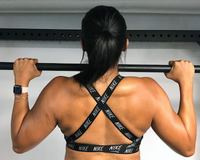The Barbell Reverse Lunge
The barbell reverse lunge is a compound exercise that activates your legs and glutes, making it a great way to sculpt your lower body.
While this may be a slightly advanced exercise, the barbell reverse lunge will take your lower body training to the next level.

Muscles Worked By The Barbell Reverse Lunge
Primary Muscle Groups:
The barbell reverse lunge primarily engages the quadriceps and the glutes. The rectus femoris, vastus intermedius, vastus medialis, and the vastus lateralis make up the four muscles of the quadriceps in the front of your leg.
This exercise places significant tension on this group of four muscles and in turn, increases the size and explosiveness of the quadriceps.

The gluteus maximus, medius, and minimus make up the three gluteal muscles. Like all lunging motions, the barbell reverse lunge significantly activates the glutes. This helps to shape the gluteus and strengthen it as a cohesive unit.

Secondary Muscle Groups:
The barbell reverse lunge secondarily engages the calves. Comprised of the soleus and the gastrocnemius, the calves activate at the bottom of each lunge as you thrust upwards.

In addition, the reverse lunge engages your back and abs. These muscles are crucial for providing upper body stability during the exercise motion.

Barbell Reverse Lunge Benefits
1. Stronger Legs and Glutes
Adding weight to the standard reverse lunge increases the tension on your body throughout the exercise motion. For that reason, the barbell reverse lunge helps to build serious lower body strength.
For those who want to increase their maximum deadlift or squat, the barbell reverse lunge can serve as a great supplementary exercise.
In addition, athletes will reap the benefits of stronger legs, as this will help boost their explosive output in nearly all sports.
2. Improved Balance
The barbell reverse lunge is a unilateral leg exercise. Without the added stability of both legs, your stabilizing muscles in your legs and glutes will activate to keep you balanced.
With consistent practice of the barbell reverse lunge, your balance will dramatically improve over time. Not only will this help you in other exercises, but you will generally be safer while completing your day-to-day activities.
3. Improved Aesthetics
The barbell reverse lunge is an intense glute and leg exercise. Whether you are trying to build a bigger, more defined, or a more toned lower body, this exercise can help you accomplish your goals.
Also, the barbell reverse lunge is a true compound exercise, as it relies on muscles throughout the body.
Therefore, your body will burn more calories than it would during less intense exercises, which may aid in weight loss as well.
How To Do The Barbell Reverse Lunge
Equipment:
For this exercise, all you need is a barbell and some weights.
Setup:
a) Load some weights onto your barbell and place it securely on your rear deltoids.
b) Start from a standing position with your feet roughly hip width apart, your chest held high, and your back straight.
Action:
a) With your left foot straight in front of you, step back with your right foot and lunge down until your right knee touches the ground. In this position, your left knee should be directly over your left ankle.
b) Next, drive upwards in a controlled fashion to the standing position.
c) Repeat this motion for your desired number of reps. Feel free to alternate legs or complete one side at a time.

Recommendation:
The barbell reverse lunge requires advanced coordination. To begin, perform 3-4 sets of 12-15 repetitions with lighter weight to master the form.
If you are using heavier weight, you can stick to the 6-8 rep range.
Barbell Reverse Lunge Mistakes
1. Completing Partial Reps
The most common barbell reverse lunge mistake is completing half reps. Simply put, if your back knee does not touch the ground, you didn’t finish a complete rep.
Make sure you maximize this exercise by doing full repetitions every time.
2. Rounding The Upper Back
Many other lifters allow the weight of the barbell to compromise their posture. When this happens, their upper body leans forward and their back forms a rounded position.
This rounded back position places too much stress on your spine and can easily cause a back injury.
To fix this mistake, focus on keeping your back straight and your body upright during the barbell reverse lunge.
3. Rushing The Motion
When lifters add weight to the lunge, they often try to rush through it as fast as possible. This leads to improper form and increases your risk of injury.
Instead, if the weight is too heavy, decrease the load and focus on completing each rep slowly. Only then will you be able to master the form so you can maximize your mind-muscle connection.
This will actually increase your gains from the barbell reverse lunge.
Barbell Reverse Lunge Variations
1. Bodyweight Reverse Lunge
No equipment? No problem! The bodyweight reverse lunge can be just as effective as the barbell variation. Keep the form the same and increase your total reps to maximize this exercise.

2. Dumbbell Reverse Lunge
If the barbell is uncomfortable for you, you can use handheld weights such as dumbbells to add resistance.
The dumbbell reverse lunge is performed with the same form as the barbell reverse lunge and it comes with the added benefit of increasing your grip strength.

3. Kettlebell Reverse Lunge Kickbacks
The reverse lunge kickback adds another glute strengthening component to the exercise motion. Grab a kettlebell with both hands, assume the starting position and lunge down on one side.
Then, as you rise upwards, kick your trail leg backwards and squeeze your glute. Then repeat the same motion on the other side!

Barbell Reverse Lunge Alternatives
If you enjoyed the barbell reverse lunge, check out these other leg and glute exercises to improve your lower body training:
1. Curtsy Lunge
Start from a standing position with your chest held high and your back straight.
With your left foot straight in front of you, step with your right foot back and to the left. Both of your knees will bend and your legs will be “crossed.” Make sure your left knee is directly over your left ankle.
Next, drive upwards in a controlled fashion to the standing position. Repeat this motion with your right foot out in front. You can switch legs after each repetition or after each set.

2. RFE Split Squat
Begin by placing your trail foot on the elevated surface behind you. Step outwards with your lead foot so that your trail leg is slightly bent.
Lean slightly forward and keep your back straight. Engage your core and squat downwards into your front leg.
Pause for a moment at the bottom of the rep and drive upwards with your lead leg. Maintain tightness in your core and repeat!

3. Goblet Squat
Grab the top of one dumbbell with both hands and assume a standing position with your feet slightly wider than shoulder width apart.
With your toes flared out, squat downwards until your hips dip below your knees. Fire up with your legs to the starting position and repeat!


Looking For A Full Glute Workout?
Check out this intense 5 minute hip & glute workout!
Join the Invasion!
This Anabolic Aliens membership will grant you access to workout classes, rehab programs, diet plans, and more exclusive content to help you achieve sustainable success!










